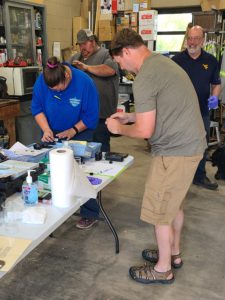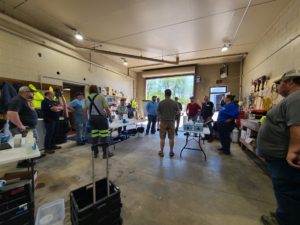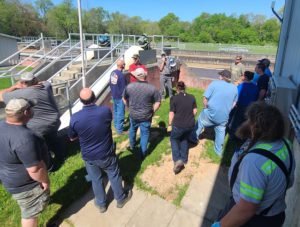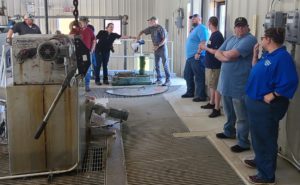Wastewater Operators Learn Nutrient Removal
If you’ve ever seen a stream choked with green algae, you know what happens when there is too much nitrogen, phosphorous, and other nutrients in water. Agricultural runoff is one of the main causes of these “algae blooms,” but potentially problematic nutrients are also present in the wastewater effluent that is released after treatment as surface water.
To learn how to better address this issue, the Elkins Wastewater Treatment Plant recently hosted a training team from the W. Va. Environmental Training Center. The team provided WWTP operators with classroom instruction and hands-on practice in removing nutrients from treated wastewater.
As part of this training, operators learned how to test wastewater for alkalinity, ammonia, phosphorus, nitrite/nitrate, and pH. Operators also learned about oxygen reduction potential (ORP) and jar testing, a process that simulates WWTP processes at a small scale to test whether changes are needed to achieve water quality goals.
“This training was really important to my operators, because there is increasing concern in our watershed about the need for nutrient removal,” says Whitney Hymes, the chief wastewater operator for the Elkins Sanitary Board. “There are likely going to be state regulations coming soon requiring nitrogen and phosphorous removal, and so we wanted to start learning about it as soon as possible. We really appreciated the visit from ETC. They put on a great class for us.”
Storm Water Update From Chief Operator
Whitney Hymes, the chief operator of the Elkins sewer utility, has provided the following update concerning recent extraordinary rain events in Elkins, obstacles for storm water management, and next steps that are being planned to continue making improvements: The past few months […]
Read More
New Loader Key to Wastewater Biosolids Program
With the delivery of a new piece of heavy equipment this week, the Elkins Wastewater Treatment Plant is positioned to continue and potentially expand a program through which sewage-treatment by-products are transformed into fertilizer for area farmers. The approximately $100,000 purchase of […]
Read More



